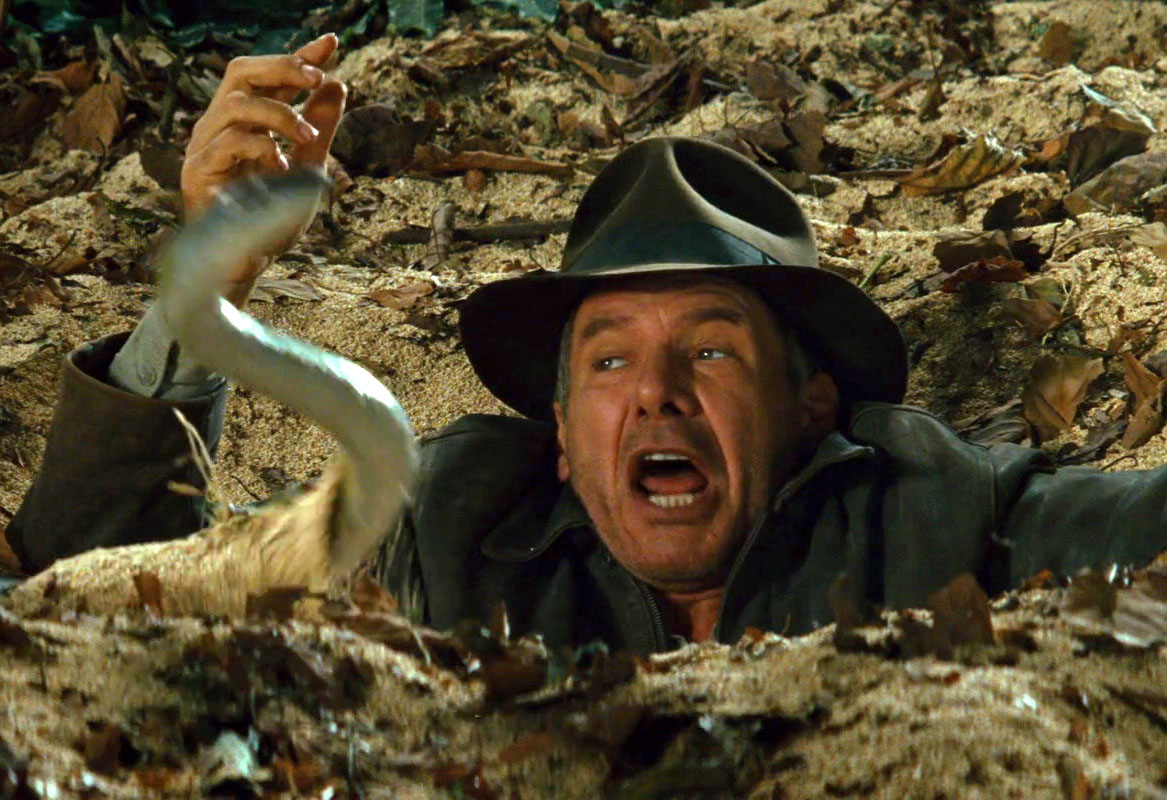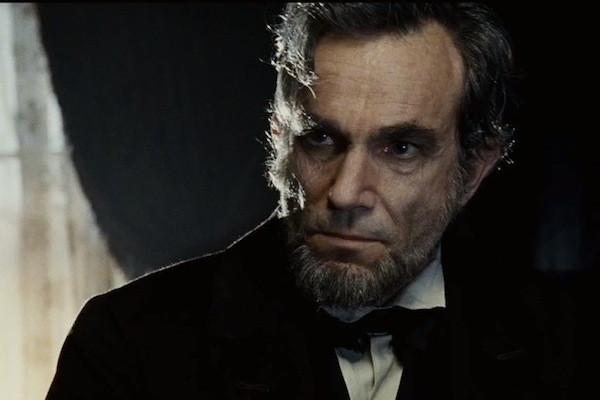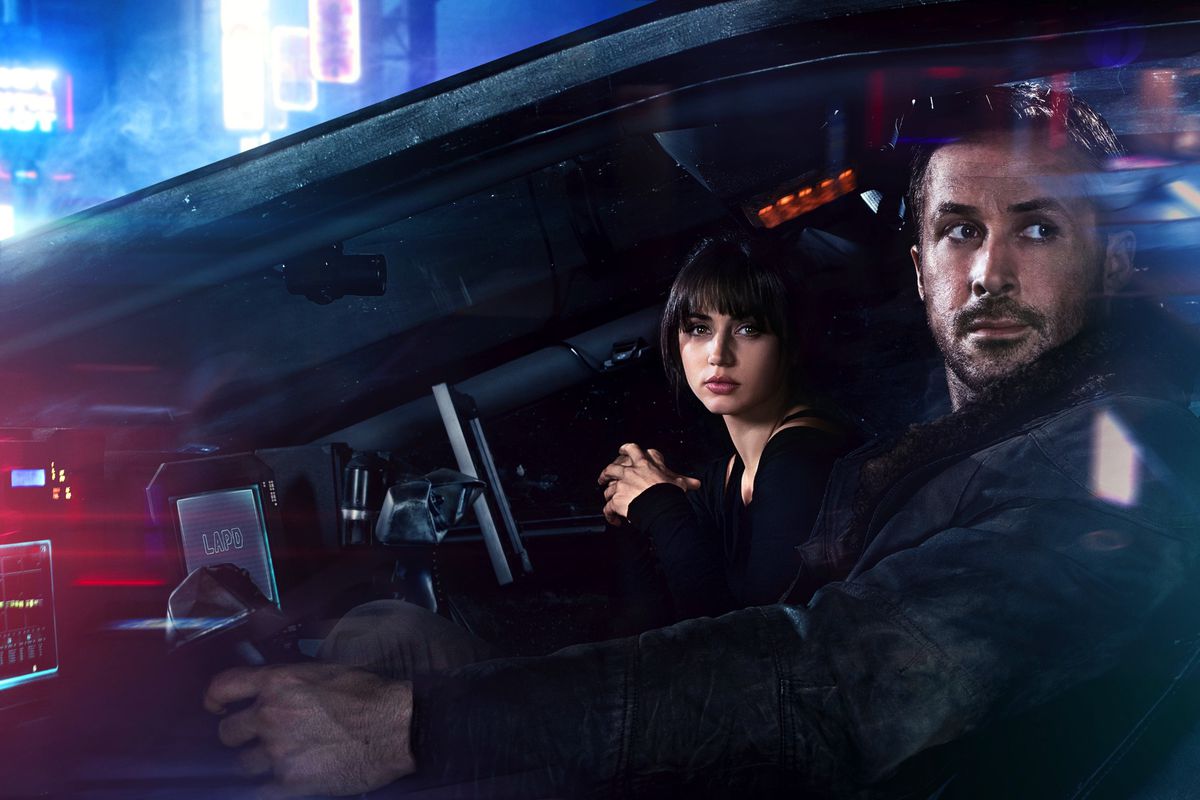Raiders of the Lost Ark (1981, Dir. Steven Spielberg):
During the second act of Raiders of the Lost Ark, our hero Indiana Jones (Harrison Ford), beset on all sides by murderous assassins in a Cairo marketplace, comes face-to-face with a particularly formidable adversary: a man dressed in magnificent black, chortling as he twirls a sword as effortlessly as a kid wielding a plastic bat. For a moment, we in the audience brace ourselves for a drawn-out, mano-a-mano showdown. Then Indy gives his opponent a “to hell with this” look, draws his pistol and casually guns the man down. The moment never failed to elicit delighted whoops and cheers at the cinema when I watched the film during its first run in 1981. It also sums up the movie’s tone—fun and cheeky, with a touch of pulp nastiness—and explains why it has endured.
Forty years since its release, Raiders is still nonpareil, even if its virtues don’t stand out as much as they did in 1981. (For good reason: its DNA has been hard-coded into countless big-budget movies since then.) The idea behind the film must have baffled studio execs: a story about a two-fisted archeologist (of all people) who battles Nazis over a Jewish relic? But if the conceit of Raiders was pure cheese, it was purely intentional. Just as he had updated the primitive 1930s Flash Gordon serials with technological gee-whiz in Star Wars, George Lucas wanted to give the old Republic cliffhanger adventures from his youth a postmodern spin. He fashioned a hero that took after those movies: the square-jawed, indestructible adventurer, usually dressed in a leather jacket and fedora, getting in and out of one scrape after another. “It’s designed to be a funhouse ride,” Lucas said at the time. Indeed, in its escalating pace, its one-thing-after-another parade of perils, Raiders essentially perfected video game storytelling, to the point where real video games from the same era stole its vibe (Pitfall for the Atari 2600, the Dragon’s Lair arcade game).
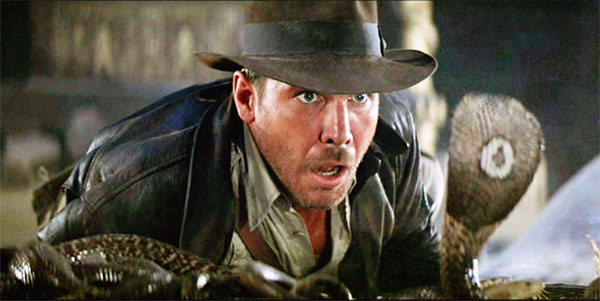
But as we know, the quality of the game depends on the actual gameplay, and that’s where Steven Spielberg came in. At the time, he wasn’t the most logical choice to helm a balls-to-the-wall adventure. Since Jaws (1975) he had detoured to more idiosyncratic projects: big-budget thinking-man sci-fi with Close Encounters of the Third Kind (1977), and a sloppy, big-budget satirical comedy with 1941 (1979). The latter’s critical and commercial failure left him at a rare low in his career, and he was reluctant to sign on to Lucas’ ambitious project, but if Raiders wasn’t exactly in his wheelhouse, it gave him a chance to recalibrate. Deliberately setting up a compact shooting schedule and relatively modest budget, he took on the assignment as an exercise in style, and as an avowed James Bond fan, he also saw it as his chance to outdo Bond at his own high-adventure game.
Raiders is thus a child of two creators, and one can sense the tug-of-war throughout as the movie tries integrating both their sensibilities. Lucas provided the supernatural elements and the coolly plotted “get to point A in order to acquire artifact that can help at Point B” storytelling, while Spielberg injected grit, humor and humanity. Later sequels would find the balance slightly out of whack, but Raiders gets it just right, taking a concept that had the potential to be a soulless exercise and giving it snap and brio. It may have the superficial qualities of a video game, but it makes for a lean, mean, joyous joyride of a game.
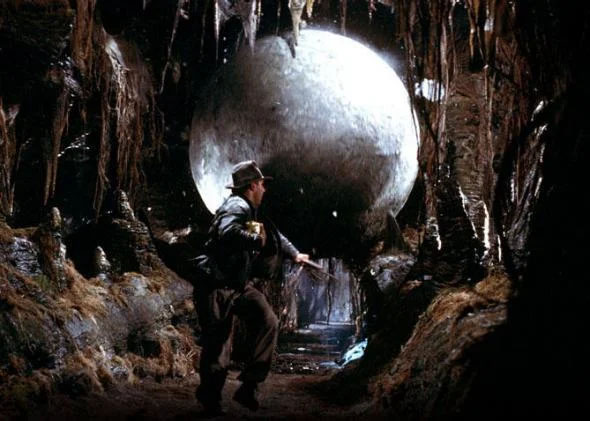
The opening sequence, in which Indy faces traitorous associates, life-threatening traps, collapsing caverns and a giant boulder, remains one of the most efficiently constructed set-pieces in action cinema, and reads like a role-playing adventure writ large. Raiders (and its sequels) are at their best in moments like this, as Lucas’s predilection for overcomplicated death traps merges with Spielberg’s whipcrack editing and sly sense of fun. Don’t worry overmuch about plot, they’re telling us; just roll with the adventure. In all other departments, including characterization, the movie keeps things light and sketchy. Indy often resembles an avatar more than an actual flesh-and-blood human, given different sets of quirks depending on scene and mood. One moment he’s a bookish, befuddled professor who’s flustered by a student who flashes a “LOVE YOU” message at him on her eyelids; in the next, he’s a roguish scoundrel who grins “Trust me” at a former flame he took advantage of when she was schoolgirl age.
But if Indy is more wish-fulfillment fantasy than character, Ford fills him out vividly, supplying physical grace and heft even as his half-mumbly line deliveries suggest a hero who really would prefer to avoid heroics. Like Spielberg, the actor wasn’t necessarily the first choice for the assignment. Worried that Ford’s role as Han Solo in Star Wars had already typecast him in the public’s eyes, Lucas and Spielberg preferred Tom Selleck, but when the latter was snapped up by the Magnum PI TV show, they reluctantly turned to Ford. (For a glimpse of how Selleck might have approached the role, see 1983’s lackluster High Road to China, in which he plays a grumpy adventurer.) Ford’s performance might not be his best, but it might be his most archetypal, as he ping-pongs between boyish wonder and middle-age grouchiness. In later movies that grouchiness would all but overwhelm the boyish wonder, but in Raiders, like Lucas and Spielberg, he gets the balance just right. Above all, his Indy is a very American type of protagonist: less courageous than reluctant, more reliant on improvisation, stamina, and sheer gumption than smarts, sophistication or finesse. (When asked how he can get out of another sticky situation, he grumbles, “I don’t know, I’m making this up as I go.”)
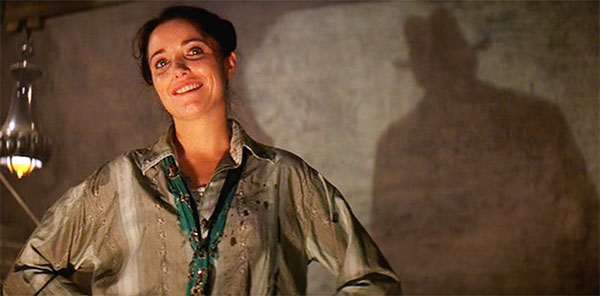
In Raiders (unlike its sequels), Ford is joined by actors who make an impression even with limited screen time. As Indy’s “local ethnic buddy with a heart of gold,” Johns Rhys-Davies radiates genuine warmth, while Ronald Lacey channels Peter Lorre as a creepy Nazi agent, and Paul Freeman makes for a crisp adversary in Belloq, a nattily attired French (natch) archeologist whose methods are even more questionable than Dr. Jones’s. Karen Allen brings feisty, two-fisted energy to her role as Marion, Indy’s jilted ex and current partner, and her repartee with Ford nudges the film towards screwball comedy, giving screenwriter Lawrence Kasdan the opportunity to shoot off some rapid-fire patter.
Even as the story barrels from one set-piece to another, Spielberg sneaks humor into the proceedings, supplying witty visual curlicues. A trained monkey who works for the bad guys gives a “Heil Hitler” salute. Every time Indy escapes a certain-death situation, he allows himself a grin of relief, only to find himself in a more precarious position seconds later. Confronting Marion, Lacey’s Nazi thug unveils what looks to be a torture device, only to reveal it’s a hanger for his coat. Both celebrating and poking gentle fun at its serial predecessors, Raiders is a cocky homage in which Lucas and Spielberg throw down the gauntlet: We can elevate these hoary conventions into pop art. Nowhere is that more apparent than in the film’s showstopper sequence, in which Indy fights his way onto and off of a truck at high speed, all the bone-jarring stuntwork performed for real, even as Lucas and Spielberg dot the action with comedic asides: a villain falling to his death with the now-famous Wilhelm scream, Indy and a Nazi officer laughing together in relief after their truck nearly crashes, followed an instant later by Indy unceremoniously knocking the soldier off the truck.
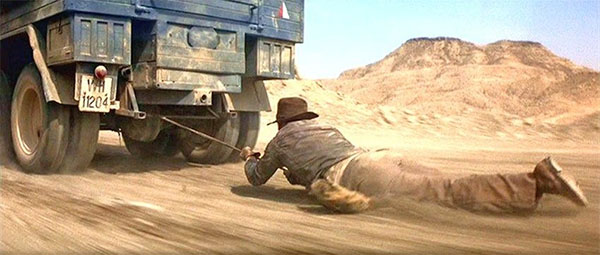
Highbrow stuff Raiders is not. One can easily imagine Spielberg flashing back to his childhood days playacting in his backyard as he put the film together, and that “boy’s adventure” tone resonates throughout, with all the mirth and immaturity such an approach suggests. The Nazis in the movie are eminently hiss-able bad guys, with about as much depth as Indians in ’40s Westerns. (True complexity would have to wait until Spielberg’s Schindler’s List in 1993.) Likewise, ethnic characters are either bug-eyed comic relief or stone-faced killers. The obstacles Indy confronts are the creepy-crawly stuff that a 9-year-old might conjure up (Snakes! Spiders! Spikes! Skulls!), and any thoughts of sexy sparks with Marion (who gets reluctantly stuffed into slinky dresses and nightgowns at every opportunity) don’t go any further than a chaste kiss, and even that comes only after a lot of pain, as Marion searches for the remaining body parts Indy hasn’t already injured.
A roller-coaster ride remarkably free of conscience or gravitas, Raiders opened the door to a wave of genre cinema that now dominates Hollywood. From outright homages like The Mummy to the recent run of Marvel movies, nearly every modern action-adventure spectacular has followed Raiders‘ lead. (Even the Bond movies Spielberg admired would rip off Raiders, placing greater emphasis on flamboyant chase scenes). The template had been set: likeable leads who are slightly out of their depth, wisecracking dialogue, tension laced with humor, extravagant set-pieces, fantastical narratives only tangentially related to life as we know it. Adolescent pictures for adolescents of all ages, in short. But while Raiders is an affectionate paean to Lucas and Spielberg’s childhood fantasies, its descendants have been more about the thrills of franchise-making, with less of the personal (and personable) touch. Even Raiders itself isn’t immune to overkill, as it climaxes with a special effects bonanza that features melting faces and exploding heads—God-level vengeance presented as a lightshow. It’s a jarring shift to horror that would be overemphasized in the next Jones film, Temple of Doom (1984), and also anticipates the overwrought effects of many an empty blockbuster production since then.
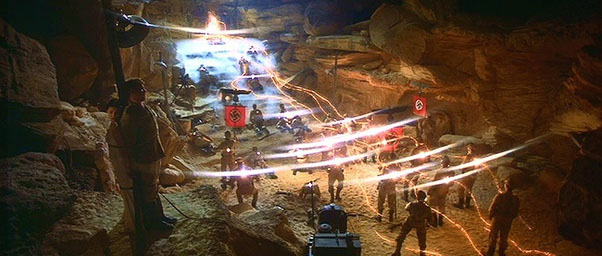
But if Raiders is ultimately a bit uneven, it’s undeniably one-of-a-kind, proud of its pulpiness even as it flouts its cinematic flair. Since its release, mainstream cinema has tried to live up to its standards, far more often failing than not. (Even Raiders‘ own sequels are lesser versions of the original.) “They don’t know what they’ve got there,” Indy grouses at film’s end as the Ark of the Covenant is secreted away in a mammoth warehouse in an undisclosed location, a mythical device returned to the vague periphery of legend. “Well, I know what I’ve got here,” Marion retorts, appraising him, the promise of an actual grown-up romance with Indy always just beyond the horizon. Grown-up stuff wouldn’t intrude on Indy’s universe until nearly four decades later in the awkward Indiana Jones and the Kingdom of the Crystal Skull, but who wants to grow up, anyway? Raiders is a film for the kid in all of us, unclouded by anything but the desire to provide a good time. Other thrill-ride movies might surpass it in spectacle or polish, but none can recapture its joie de vivre. ■


